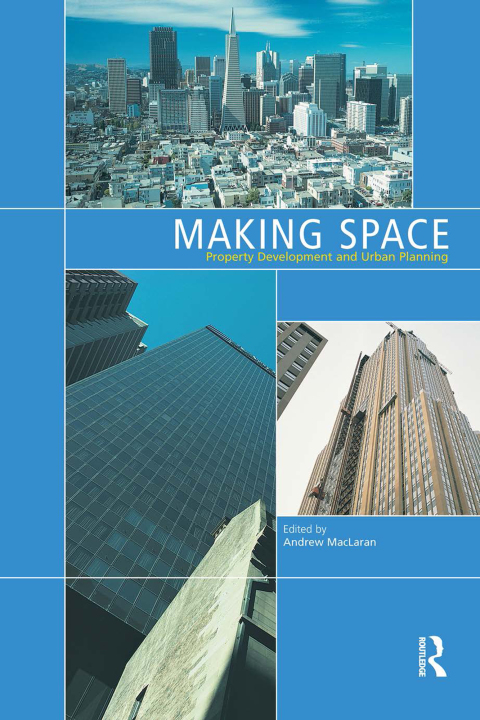Description
Efnisyfirlit
- Cover Page
- Half Title page
- Title Page
- Copyright Page
- Contents
- Acknowledgements
- List of Contributors
- Preface
- 1 Creating urban space
- 2 Masters of space: the property development sector
- 2.1Development operations
- 2.1.1Peripheral expansion
- 2.1.2Internal modification
- 2.2Modelling development: a property ‘industry’?
- 2.3Development roles and relationships
- 2.3.1Developers (commercial capital)
- 2.3.2Landowners (landed capital)
- 2.3.3Development financiers (finance capital)
- 2.3.4Building contractors (industrial capital)
- 2.3.5Long-term investors (investment capital)
- 2.3.6 Tenants
- 2.4 Considerations
- 2.5 A profitable business?
- 2.6 The driving force: profit
- 2.6.1 Yields
- 2.6.2 Rents
- 2.7 Property cycles
- 2.7.1 Upturn and acceleration
- 2.7.2 Boom
- 2.7.3 Investment-driven development
- 2.7.4Over-supply
- 2.7.5Bust
- 2.7.6Consequences
- 2.8The impact of global capital flows
- 2.9The impact of development cycles
- 2.9.1The developer—landowner relationship
- 2.9.2The developer—financier relationship
- 2.9.3Relationship between the developer and construction interests
- 2.9.4The developer—investor relationship
- 2.10 Notes
- 3 Planning the city
- 3.1 Introduction
- 3.2 Urban planning as a state activity
- 3.3 Planning practice
- 3.4 Shaping the urban landscape: the genesis of urban planning
- 3.5Planning ideology
- 3.6Conceptions of the state and the role of urban planning
- 3.6.1Pluralism
- 3.6.2Managerialism
- 3.6.3Reformism
- 3.6.4Marxist political economy
- 3.6.5 Post-Marxian critiques and postmodern planning
- 3.7 Urban planning and urban development
- 3.8 Planners and developers
- 3.9 Entrepreneurialism in urban planning
- 3.10 Conclusions
- 4 The rejuvenation of downtown Minneapolis: urban planning as a creature of private-sector interests
- 4.1 Introduction
- 4.2 The context
- 4.3 Private sector initiatives
- 4.3.1 The Downtown Council and the reconstitution of urban planning
- 4.3.2 Nicollet Mall
- 4.3.3 The Skyway system
- 4.3.2 The IDS Center
- 4.4 Public intervention: a pro-active approach
- 4.5 The impact of policy: evidence of rejuvenation
- 4.6 Misgivings and re-apprail
- 4.7 Towards an alternative development strategy for greater community benefit
- 4.7.1 The Minneapolis Comprehensive Plan
- 4.7.2 The Minneapolis Downtown 2010 plan
- 4.7.3 The Minneapolis Neighborhood Revitalization Program (NRP)
- 4.8 The Target Project: planning reverting to type?
- 4.9 Conclusion
- 4.10 Notes
- Acknowledgments
- 5 Planning central Sydney
- 5.1 Introduction
- 5.2 Sydney’s evolving urban planning framework
- 5.2.1 The contemporary legislative framework
- 5.3 At the coalface: planning and city centre development to the 1970s
- 5.3.1 The development boom 1968–1974
- 5.3.2 Planning and the boom
- 5.4 New roles and new planning regimes: planning central Sydney since the 1980s
- 5.4.1 City centre development
- 5.5Evaluating central Sydney planning
- 5.6Conclusion
- 5.7 Notes
- 6 Dublin: property development and planning in an entrepreneurial city
- 6.1 Introduction
- 6.2 The planning context
- 6.2.1 Development plans
- 6.2.2 Development control
- 6.3 Limitations of traditional urban planning in Dublin
- 6.3.1 Constitutionality and constraint
- 6.3.2 Contextual isolation
- 6.3.3 The permissory basis of the system
- 6.3.4 Political pressure
- 6.3.5 Planning by prescriptive formulae
- 6.4 Developers and investors
- 6.5 Development activity
- 6.6 Urban planning and development
- 6.6.1 Development scale
- 6.6.2 Site assembly and dereliction
- 6.6.3 Plot density and displacement
- 6.6.4 Building protection
- 6.7 Towards interventionist approaches in planning
- 6.7.1 Designated areas
- 6.7.2 Docklands
- 6.7.3 Temple Bar
- 6.7.4 Enterprise areas
- 6.8 Development impact of the initiatives
- 6.8.1 Misgivings
- 6.8.2 The impact on planning
- 6.9 Development in the 1990s: new problems and Edge City
- 7 Remaking the city: property processes, planning and the local entrepreneurial state in Auckland
- 7.1 Introduction
- 7.2 The New Zealand planning context
- 7.3 Office development processes: agents of change1
- 7.4 The inner-city apartment market
- 7.5The entrepreneurial local state and the city of spectacle
- 7.5.1Sky City casino
- 7.5.2The Britomart development
- 7.5.3Viaduct Harbour
- 7.6Conclusions
- 7.7 Notes
- 8 Reshaping and reinventing the city of Birmingham, UK: planning for enterprise and the information society
- 8.1Introduction
- 8.2The national planning context
- 8.3The development context and the Birmingham Alliance
- 8.4The city of Birmingham — a city-region in transition
- 8.5Highbury and the city-centre strategy
- 8.6Westside story — Brindleyplace: 1983–2002
- 8.7Eastside story — Millennium point: 1997-
- 8.8Birmingham’s dilemmas
- 8.9Conclusion
- 9 Growth machines and growth pains: the contradictions of property development and landscape in Sioux Falls South Dakota
- 9.1 Introduction
- 9.2 Landscape, property and growth in Sioux Falls
- 9.2.1 Property and the growth machine
- 9.2.2 The growth machine in the urban landscape
- 9. 3Property, landscape and marginalization in downtown Sioux Falls
- 9. 4Conclusion
- 9.5 Notes
- Acknowledgements
- Bibliography
- Index





